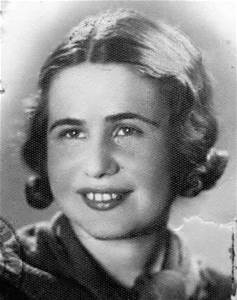题目内容
1. PEOPLE NOBLE SMUGGLER
PEOPLE NOBLE SMUGGLERThis Thursday,Irena Sendler will be honoured for her work as a smuggler(偷运者).During World WarⅡ,the Polish social worker smuggled nearly2,500Jewish children out of the Warsaw ghetto(聚居区).She gave them new identities,found them safe places with good-hearted Christians,and kept the children's real names buried in jars in her neighbours'gardens.(The play,Life in a Jar,based on her story,is being performed.)At 93,Sendler lives in a Warsaw nursing home and is too weak to travel to Washington D.C.,to receive the 2003Jan Karski Award for Valorand Compassion from the American Center of Polish Culture.One of the children she saved will accept the award for her.
You risked your life to save the children.
I was taught by my father that when someone is drowning,you don't ask if they can swim,you just jump in and help.During the war,everyone was drowning,but mostly the Jewish children.
How did you persuade parents to give up their children?
I had to answer honestly that I didn't even know if we would get past the guards.
What was the most frightening moment?
When I saw a priest(牧师)in charge of an orphan age for Jewish children in the ghetto walk with them out to be killed.The children were in then best Sunday suits.The priest was killed with them.
How did you get the children to behave as you smuggled them out?
I told the older children to act as if they were sick and sometimes gave the younger ones a sleeping pill.They were told to remember their new names.I also told the children to tell guards they had only been visiting a servant in the ghetto and were going back to their real homes outside.
Did you tell your own two children what you did?
I never told them.Only when my daughter went to Israel did she learn all about me.I thought it was only normal to do so.And it was a very painful subject.It was always on my mind that I couldn't do more.
--Samantha Levine
66.We can learn from the passage that Irena SendlerD.
A.will go to Washington to accept the award with her daughter
B.was caught a few times while she was rescuing the Jewish children
C.told those parents that their children's lives would be guaranteed
D.saved thousands of Jewish children at the risk of her ownlife
67.The expression"everyone was drowning"can best be replaced by"C".
A.everyone was involved in the war
B.all the people were drowned
C.all the people were facing danger and death
D.Jewish children were being killed
68.Which of the following could NOT be expected when Sendler was smuggling the Jewish children?A
A.The children pretended to be brothers and sisters from one big family.
B.Some children pretended to be returning home after visiting servants in the ghetto.
C.The children were asked to remember and use new names instead of real ones.
D.Some children were told to pretend to be sick in front of the guards.
69.Which of the following is best for the blank in the title?B
A.DISASTER SURVIVOR
B.NOBLE SMUGGLER
C.AWARD RECEIVER
D.SECRET DEFENDER.
分析 本文主要介绍了伊雷娜•森德勒为了让犹太儿童生存下来,冒着生命危险把他们从华沙的聚居区偷运出来,帮他们获得新生的故事.
解答 66.D 细节理解题.根据第一段的"During World WarⅡ,the Polish social worker smuggled nearly2,500 Jewish children out of the Warsawghetto"可知,二战期间,伊雷娜•森德勒冒着生命危险救了数千名犹太儿童.故选D.
67.C 词义猜测题.根据此句前面的"I was taught by my father that when someone is drowning,you don't ask if they can swim,you just jump in and help"当有人溺水时,你不能问他是否会游泳,你只要跳进水中去救他,可知everyone was drowning实际表示的是每个人都面临着危险和死亡.
68.A 细节理解题.根据"I told the older children to act as if they were sick and sometimes gave the younger ones a sleeping pill"可知选项A正确;根据"I also told the children to tell guards they had only been visiting a servant in the ghetto and were going back to their real homes outside可知选项B正确;根据"They were told to remember their new names"可知选项C正确.故选A.
69.B 主旨大意题.根据全文内容可知,伊雷娜•森德勒尽管是个偷运者,但是她偷运的是处于生死边缘的犹太儿童,因此她是一个高尚的偷运者.故选B.
点评 本篇文章是人物故事类阅读,主要考查学生的细节理解能力以及推理判断能力.阅读这类文章要抓住题干关键词,采用寻读定位的方法查找细节.推理判断题要基于文章内容,以文章提供的事实和线索为依据,立足已知,推断未知.不能主观臆想,凭空想象,随意揣测.

| A. | get across | B. | get through | C. | get down | D. | get over |
| A. | beyond | B. | without | C. | across | D. | over |
| A. | she realized | B. | did she realize | ||
| C. | she had realized | D. | had she realized |
| A. | behind | B. | against | C. | about | D. | at |
 In my first week as a graduate student at Cambridge University in 1964I met with a fellow student,two years ahead of me in his studies; he was unsteady on his feet and spoke with great difficulty.This was Stephen Hawking.I learned that he had a bad disease and might not live long enough even to finish his PhD degree.
In my first week as a graduate student at Cambridge University in 1964I met with a fellow student,two years ahead of me in his studies; he was unsteady on his feet and spoke with great difficulty.This was Stephen Hawking.I learned that he had a bad disease and might not live long enough even to finish his PhD degree.